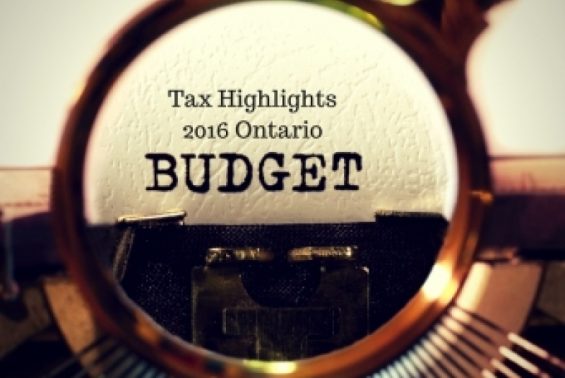The 2016 Ontario Budget was announced February 25, 2016 . It shows a deficit of $5.7B in 2016, $4.3 B in 2017, and a balanced budget in 2018.
The proposal shows government investment in building a strong and health economy by investing in skilled workforce, advancements in innovative manufacturing and clean technology, enhancements to infrastructure, and strategies for developed for improving health care and support services needed for the growth of a fair society.
Tax related measures outlined in the 2016 Ontario Budget are included below:
Business Taxes
Research & Development Tax Credit
Ontario Research and Development Tax Credit (ORDTC) to be reduced from 4.5% to 3.5%. Rate of the Ontario Innovation Tax Credit to be reduced from 10% to 8% for eligible research and development (R&D) expenditures incurred in taxation years that end on or after June 1, 2016. Revenue to be reinvested in manufacturing, college based innovation projects, and research. Tax rate reductions will be prorated for taxation years overlapping June 1, 2016.
Small Business Dividend Tax Credit and Gross-Up
Ontario will parallel the federal 2015 budget tax changes that include reductions in the federal small business corporate income tax rate over four years. Non-Eligible dividend tax credit rate will be lowered from 4.5 per cent for 2015 to 4.2864 per cent in 2016.
Apprenticeship Training Tax Credit
The current tax credit is based on salaries and wages paid to an apprentice. Qualifying businesses can claim 25 per cent of eligible expenditures (30 per cent for small businesses) made during the first 36 months of an apprenticeship program that commenced on or after April 24, 2015. The maximum credit for each apprenticeship is $5,000 per year. The maximum credit over the first 36‑month period of the apprenticeship is $15,000.
In the recent budget, the Ontario government states that it is committed to this program. The program is under review and announcement to changes will be made in 2016. Download details about the Apprenticeship Training Tax Credit Program
Cap and Trade
Ontario introduced legislation on February 24, 2016 to implement its cap and trade program to reduce greenhouse gas emissions. The budget includes details of the program, which will take effect on January 1, 2017.
Ontario’s cap and trade program would place a cap on greenhouse gas (GHG) emissions. The Province will distribute carbon tax credit allowances; certain amount free-of-charge & others to be available for auction. Under these new regulations, businesses that have carbon emissions would have to hold allowance for every tonne of greenhouse gas emissions they put into the air. As the cap declines each year, to be compliant, they would have to reduce their emissions or purchase carbon tax credits. Revenue generated will be reinvested to help reduce overall GHG emissions.
Individual Taxes
- Student Tuition – As of Fall 2017, the government proposes to discontinue the Ontario tuition and education tax credits. Revenue from eliminating these tax credits will go towards student grant programs.
- Children’s Activity Tax Credit – As of January 1, 2017, proposal is to end the CATC . Instead, money will be invested in programs to encourage physical activity and healthy eating for Ontario’s children, such as the Healthy Kids Strategy.
- Healthy Homes Renovation Tax Credits – As of January 1, 2017, the government proposes to end the HHRTC; a tax that was implemented help with the costs of renovations to improve safety and accessibility for seniors to be able to live independently in their homes. Monies will be redirected to other similar services.
- Tax-Free Savings Accounts – Ontario will parallel the federal government reduction of TFS accounts from $10,000 in 2015 to $5,500 in 2016.
- Split Income Tax – Starting January 1, 2016 top marginal Personal Income Tax (PIT) rates will be applied to tax income splits as it relates to certain children. All such splits will taxed at 20.53 per cent, and no surtax would be payable to that income.
Tobacco Tax
As of February 25, Ontario tobacco tax will increase from 13.975 cents to 15.475 cents per cigarette and per gram of tobacco products other than cigars.
Alcohol Charges
Effective June 2016, there is a proposed increase of 2% that the LCBO would put on ad valorem mark-up for wine. Further increased by 2% April 2017, and April 2019 respectively.
Non-Ontario wine will have a 1% increase in starting June 2016, then again in April 2017, 2018, and 2019. Minimum retail price for table wine and cider will increase to $7.95, phased in over three years.
Property Tax for Farmers
Farmers have noted that current property tax increases are working against them when trying to expand and diversify their operations. The Province will be working with the farming community and municipal sector to provide sustainable property tax treatment to farmers that engage in small-scale, value-added activities as part of their farming business, while maintaining a level playing field for large processors.
Ontario Registered Pension Plan
The government is working towards a pension regulatory landscape to encourage offer flexible retirement options, and ensure pension plans continue to be a viable retirement savings tool in different economic conditions. An overview of recent government decisions on the proposed plan design of the Ontario Retirement Pension Plan (ORPP).
Employer verification and enrolment process for the ORPP will begin in 2017, with collection of contributions by both employers and employees beginning in 2018. The budget includes an updated timeline for the phase-in of employer contribution rates; starting with medium and large businesses, and then everyone phased in by 2021. Employee contribution rates will match the rates for employers. The contribution rate applies to pensionable earnings up to a maximum amount of $90,000.
More about the 2016 Ontario Budget – www.fin.gov.on.ca/en/budget/ontariobudgets/2016
